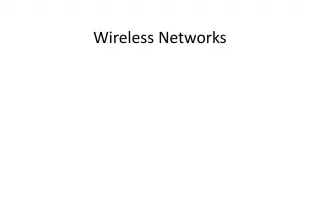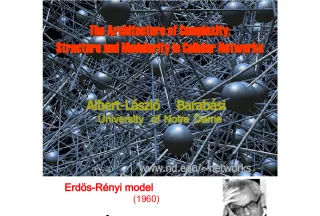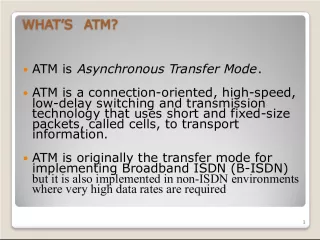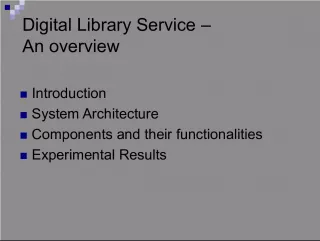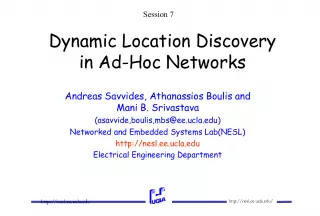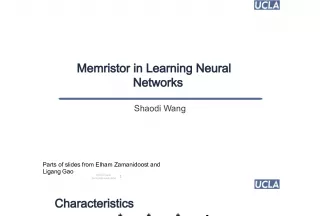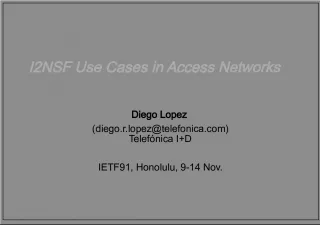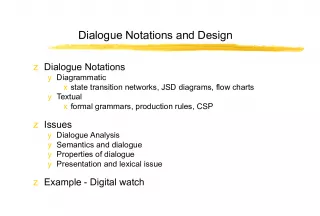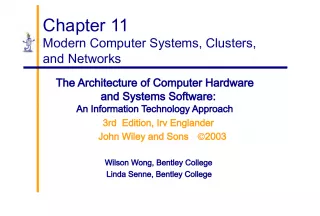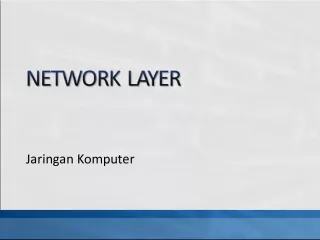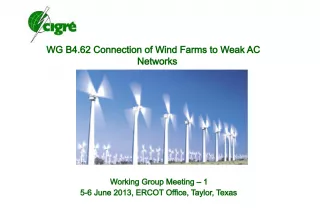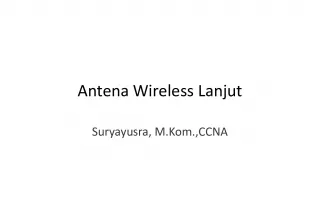Understanding Wireless Networks and MANET
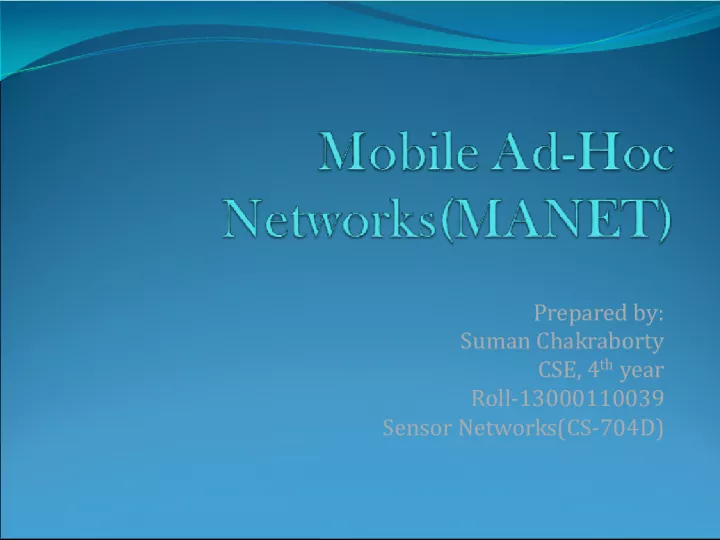

This article provides an overview of wireless networks, including the history and features of MANET, as well as the problems with security and routing protocols. The need for access to computing and communication services on the move is discussed, including infrastructure-based networks and ad hoc networks.
- Uploaded on | 0 Views
-
 susanmiller
susanmiller
About Understanding Wireless Networks and MANET
PowerPoint presentation about 'Understanding Wireless Networks and MANET'. This presentation describes the topic on This article provides an overview of wireless networks, including the history and features of MANET, as well as the problems with security and routing protocols. The need for access to computing and communication services on the move is discussed, including infrastructure-based networks and ad hoc networks.. The key topics included in this slideshow are wireless networks, MANET, ad hoc networks, routing protocols, security,. Download this presentation absolutely free.
Presentation Transcript
1. Prepared by: Suman Chakraborty CSE, 4 th year Roll-13000110039 Sensor Networks(CS-704D)
2. Overview: Wireless Networks MANET Ad-Hoc Network vs. MANET Hybrid MANET History of MANET Features of MANET MANET Routing Protocols Problems in MANET Security Conclusion
3. Wireless Networks: Need: Access computing and communication services, on the m ove Infrastructure-based Networks traditional cellular systems (base station infrastructure) Wireless LANs Infrared (IrDA) or radio links (Wavelan) very flexible within the reception area; ad-hoc networks possible low bandwidth compared to wired networks (1-10 Mbit/s) Ad hoc Networks useful when infrastructure not available, impractical, or expensive military applications, rescue, home networking
4. Cellular Wireless: Single hop wireless connectivity to the wired world Space divided into cells A base station is responsible to communicate with hosts in its cell Mobile hosts can change cells while communicating Hand-off occurs when a mobile host starts communicating via a new base station
5. Multi hop Wireless: May need to traverse multiple links to reach destination Mobility causes route changes
6. Mobile Ad-Hoc Network(MANET): Host movement frequent Topology change frequent No cellular infrastructure. Multi-hop wireless links. Data must be routed via intermediate nodes. A B A B
7. Why Ad-Hoc Networks: Setting up of fixed access points and backbone infrastructure is not always viable Infrastructure may not be present in a disaster area or war zone Infrastructure may not be practical for short-range radios; Bluetooth (range ~ 10m) Ad hoc networks: Do not need backbone infrastructure support Are easy to deploy Useful when infrastructure is absent, destroyed or impractical
8. Mobile Ad-Hoc Network: Self-configuring network of mobile routers (and associated hosts) connected by wireless links This union forms a random topology Routers move randomly free Topology changes rapidly and unpredictably Standalone fashion or connected to the larger Internet
9. Ad-Hoc Network vs. MANET: Increase of mobile applications Additional challenges Changes to the network topology Need of extreme network flexibility Answer = Mobile Ad-hoc Network While MANETs are self contained, they can also be tied to an IP-based global or local network Hybrid MANETs
10. Hybrid MANET:
11. Hybrid MANET:
12. Hybrid MANET:
13. History of MANET: Earliest MANETs were called packet radio networks, sponsored by DARPA (1970) These packet radio systems predated the Internet and were part of motivation of the original IP suite Later DARPA experiments included the Survivable Radio Network (SURAN) project (1980s) 1990s the advent of inexpensive 802.11 radio cards for personal computer Current MANETs are designed primary for military utility; examples include JTRS (Joint Tactical Radio System) and NTDR (Near-Term Digital Radio).
14. Features of MANET: Autonomous terminal: A node may function as both host and a router. Distributed Operations: since there is no fixed network the control and management operations are distributed among the terminals. Multi-hop routing: packets should be delivered via one or more nodes. Dynamic network topology: As the network change rapidly, the mobile nodes dynamically establish routing among themselves i.e. they form their own networ k
15. Routing Protocols for MANET: Two types of routing protocols: 1. Table-Driven Routing Protocols Destination-Sequenced Distance-Vector Routing (DSDV) Cluster head Gateway Switch Routing (CGSR) The Wireless Routing Protocol (WRP) 2. Source-Initiated On-Demand Routing Protocols Ad-Hoc On-Demand Distance Vector Routing (AODV) Dynamic Source Routing (DSR) Temporally-Ordered Routing Algorithm (TORA) Associativity-Based Routing (ABR) Signal Stability Routing (SSR)
16. MANET Routing Protocols:
17. Destination-Sequenced Distance- Vector Routing (DSDV): Each node maintains a routing table which stores next hop, cost metric towards each destination a sequence number that is created by the destination itself Each node periodically forwards routing table to neighbors Each node increments and appends its sequence number when sending its local routing table Each route is tagged with a sequence number; routes with greater sequence numbers are preferred Each node advertises a monotonically increasing even sequence number for itself When a node decides that a route is broken, it increments the sequence number of the route and advertises it with infinite metric Destination advertises new sequence number
18. DSDV Routing: When X receives information from Y about a route to Z Let destination sequence number for Z at X be S(X), S(Y) is sent from Y If S(X) > S(Y), then X ignores the routing information received from Y If S(X) = S(Y), and cost of going through Y is smaller than the route known to X, then X sets Y as the next hop to Z If S(X) < S(Y), then X sets Y as the next hop to Z, and S(X) is updated to equal S(Y) X Y Z
19. Cluster head Gateway Switch Routing (CGSR): Uses DSDV as an underlying protocol and Least Cluster Change (LCC) clustering algorithm A cluster head is able to control a group of ad-hoc hosts Each node maintains 2 tables: 1. A cluster member table, containing the cluster head for each destination node 2. A DV-routing table, containing the next hop to the destination The routing principle: Lookup of the cluster head of the destination node Lookup of next hop Packet send to destination Destination cluster head delivers packet
20. CGSR:
21. The Wireless Routing Protocol (WRP): Table-based protocol with the goal of maintaining routing information among all nodes in the network Each node is responsible for four tables: Distance table Routing table Link-cost table Message retransmission list (MRL) table Link exchanges are propagated using update messages sent between neighboring nodes Hello messages are periodically exchanged between neighbors This protocol avoids count-to-infinity problem by forcing each node to check predecessor information Drawbacks: 4 tables requires a large amount of memory and periodic hello message consumes power and bandwidth
22. Source-Initiated On-Demand Routing Protocols: Ad-Hoc On-Demand Distance Vector Routing (AODV) Builds on DSDV algorithm and the improvement is on minimizing the number of required broadcasts by creating routes on an on-demand basis (not maintaining a complete list of routes) Broadcast is used for route request Advantages: uses bandwidth efficiently, is responsive to changes in topology, is scalable and ensures loop free routing Drawbacks: nodes use the routing caches to reply to route queries. Result: uncontrolled replies and repetitive updates in hosts caches yet early queries cannot stop the propagation of all query messages which are flooded all over the network
23. Dynamic Source Routing (DSR): Based on the concept of source routing Mobile nodes are required to maintain route caches that contain the source routes of which the mobile is aware 2 major phases: Route discovery uses route request and route reply packets Route maintenance uses route error packets and acknowledgments Advantages: No periodic hello message and fast recovery - cache can store multiple paths to a destination Drawbacks: the packets may be forwarded along stale cached routes. It has a major scalability problem due to the nature of source routing. Same as AODV, nodes use the routing caches to reply to route queries
24. Route Discovery in DSR: Represents a node that has received RREQ for D from S B A S E F H J D C G I K Z M N L Y
25. Route Discovery in DSR: B A S E F H J D C G I K Represents transmission of RREQ Z Y Broadcast transmission M N L [S] [X,Y] Represents list of identifiers appended to RREQ
26. Route Discovery in DSR: B A S E F H J D C G I K Node H receives packet RREQ from two neighbors: potential for collision Z Y M N L [S,E] [S,C]
27. Route Discovery in DSR : B A S E F H J D C G I K Node C receives RREQ from G and H, but does not forward it again, because node C has already forwarded RREQ once Z Y M N L [S,C,G] [S,E,F]
28. Route Discovery in DSR: B A S E F H J D C G I K Z Y M Nodes J and K both broadcast RREQ to node D Since nodes J and K are hidden from each other, their transmissions may collide N L [S,C,G,K] [S,E,F,J]
29. Route Discovery in DSR: B A S E F H J D C G I K Z Y Node D does not forward RREQ, because node D is the intended target of the route discovery M N L [S,E,F,J,M]
30. Temporally-Ordered Routing Algorithm (TORA): Highly adaptive, loop-free, distributed routing algorithm based on the concept of link reversal Proposed to operate in a highly dynamic mobile networking environment It is source initiated and provides multiple routes for any desired source/ destination pair This algorithm requires the need for synchronized clocks
31. Temporally-Ordered Routing Algorithm (TORA): 3 basic functions: Route creation Route maintenance Route erasure Advantages: provides loop free paths at all instants and multiple routes so that if one path is not available, other is readily available. It establishes routes quickly so that they may be used before the topology changes. Drawbacks: exhibits instability behavior similar to "count-to-infinity" problem in distance vector routing protocols.
32. Associativity-Based Routing (ABR): Free from loops, deadlock, and packet duplicates, and defines a new routing metric for ad-hoc mobile networks Each node generates periodic beacons (hello messages) to signify its existence to the neighbors These beacons are used to update the associativity table of each node With the temporal stability and the associativity table the nodes are able to classify each neighbor link as stable or unstable.
33. Associativity-Based Routing (ABR):
34. Signal Stability Routing (SSR): descendent of ABR and ABR predates SSR it selects routes based on signal strength between nodes and on a nodes location stability thus offers little novelty SSR route selection criteria has effect of choosing routes that have stronger connectivity and it can be divided into: Dynamic Routing Protocol (DRP) or Static Routing Protocol (SRP)
35. Signal Stability Routing (SSR): DRP is responsible for maintenance of signal stability table and routing table SRP processes packets by passing the packets up the stack if it is the intended receiver and forwarding the packet if it is not Advantages: to select strong connection leads to fewer route reconstruction Drawbacks: long delay since intermediate nodes cant answer the path (unlike AODV, DSR)
36. Problems in MANET: Routing Security and Reliability Quality of Service Internetworking Power Consumption
37. Security in MANET: A major issue in Mobile ad-hoc network is SECURITY . Two approaches in protecting mobile ad-hoc networks Reactive approach : Seeks to detect security threats and react accordingly. Proactive approach : Attempts to prevent an attacker from launching attacks through various cryptographic techniques
38. Conclusion: A Mobile Ad-hoc network is a wireless ad-hoc network which is used to exchange information. Other interesting issues: Applications for MANET Address assignment QoS issues Improving interaction between protocol layers
39. Thank You!!!
